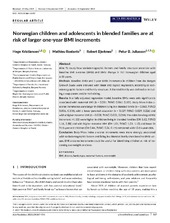Norwegian children and adolescents in blended families are at risk of larger one-year BMI increments
Peer reviewed, Journal article
Published version

View/
Date
2020Metadata
Show full item recordCollections
Original version
https://doi.org/10.1111/apa.15019Abstract
Aim: To study how sociodemographic factors and family structure associate with baseline BMI z‐scores (BMIz) and BMIz change in 767 Norwegian children aged 6‐15 years. Methods: Baseline BMIz and 1‐year BMIz increments in children from the Bergen Growth Study were analysed with linear and logistic regression, according to sociodemographic factors and family structure. A blended family was defined as including a step‐parent and/or half‐sibling. Results: In a fully adjusted regression model, baseline BMIz were only significantly associated with maternal BMI (b = 0.087, 95%CI 0.067, 0.107). Body Mass Index z‐scores increments were larger in children living in a blended family (b = 0.060, 95%CI 0.006, 0.115), with a lower parental education (b = 0.127, 95%CI 0.029, 0.226) and with a higher maternal BMI (b = 0.008, 95%CI 0.001, 0.014). The odds for a large BMIz increment (>1 SD) were higher in children living in blended families (OR 1.82, 95%CI 1.16, 2.88) and with higher maternal BMI (OR 1.07, 95%CI 1.01, 1.13) and lower in 9‐11‐year‐old children (OR 0.44, 95%CI 0.26, 0.77) compared with 12‐15‐year‐olds. Conclusion: Body Mass Index z‐scores increments were more strongly associated with sociodemographic factors and living in a blended family than baseline BMIz values. BMI z‐scores increments could be useful for identifying children at risk of becoming overweight or obese.
